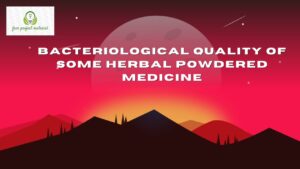ABSTRACT
This study on the microbiology of pre and grilling suya sold in Ikot Ekpene was carried out using standard microbiological methods. The result of the study revealed various microbial contamination with bacterial count ranging from 2.2×105 to 6.4×105 CFU/g while the fungal counts ranged from 1.2×106 to 7.3×106 CFU/g. Bacterial isolates revealed the presence of Bacillus sp, Staphylococcus sp, Klebsiella sp, Streptococcus sp, Micrococcus sp and Enterobacter sp of which Staphylococcus sp had the highest percentage occurrence (40.6%) while Klebsiella sp had the least (3.1%). Fungal isolates revealed the presence of Fusarium sp, Aspergillus sp and Penicillium sp with Aspergillus sp having the highest percentage occurrence (46.6%) while Fusarium sp had the least (13.5%). The antimicrobial susceptibility test of the bacteria isolated from the suya samples revealed Klebsiella sp was sensitive to Augmentin (10mcg) while Enterobacter sp was sensitive to Peflacin (20mcg) but was resistant to other antibiotics. Other bacterial isolates showed resistance to all the antibiotics. The prevalence of antibiotic resistance bacteria could lead to epidemiological outbreaks. Even though some microbial counts are at tolerable limits (<105 CFU/ml), they could still be of public health concerns as conditions favouring growth and proliferation prevails in most of the retail outlets. Thus, it is recommended that in order to achieve food safety quality for vended suya across the different locations in Ikot Ekpene, there is need for hygiene in food safety and education on the imminent risk of consuming contaminated suya.
TABLE OF CONTENTS
Title page – – – – – – – – – i
Declaration – – – – – – – – – ii
Certification – – – – – – – – – iii
Dedication – – – – – – – – – iv
Acknowledgement – – – – – – – – v
Abstract – – – – – – – – – vi
Table of contents – – – – – – – – vii
List of tables – – – – – – – – viii
CHAPTER ONE: INTRODUCTION
1.2 Background of the Study – – – – – – 1
1.3 Aim and Objective of the Study – – – – – 3
CHAPTER TWO: LITERATURE REVIEW
2.1 Suya – – – – – – – – – 4
2.2 Suya Processing – – – – – – – 4
2.3 Hygiene Practices of Suya Processing – – – – 5
2.4 Processing Effect on Suya – – – – – 7
2.5 Risk Source and Public Health Implication – – 8
2.6 Microbiological Quality of Suya – – – 10
2.7 Microorganisms Associated with Suya – – – 12
2.8 Health Hazard Associated with Microorganisms
from Suya – – – – – – – – 14
CHAPTER THREE: MATERIAL AND METHOD
3.1 Material and Reagents – – – – – 16
3.2 Sample Collection – – – – – – 16
3.3 Microbiological Analysis – – – – – 17
3.4 Characterization of Bacterial Isolates – – – 18
3.5 Identification of Fungal Isolates – – – – 18
3.6 Antibacterial Susceptibility Testing – – – 19
CHAPTER FOUR: RESULTS AND DISCUSSION
4.1 Results – – – – – – – 21
4.1.1 Total bacterial Count of Suya Samples – – – 21
4.1.2 Total Fungal Count of Suya Samples – – – 21
4.1.3 Morphological and Biochemical Identification
of Bacterial Isolates – – – – – 21
4.1.4 Macroscopic and Microscopic Identification of
Fungal Isolates – – – – – – 22
4.1.5 Occurrence of Bacterial Isolates in Suya Sample – 22
4.1.6 Occurrence of Fungal Isolates in Suya Samples – 22
4.1.7 Antibacterial Susceptibility Pattern of Bacterial Isolates – 22
4.2 Discussion – – – – – – – 30
CHAPTER FIVE: CONCLUSION AND RECOMMENDATIONS
5.1 Conclusion – – – – – – – 38
5.2 Recommendations – – – – – – 39
References
Appendix
LIST OF TABLES
Table 4.1 Total bacterial Count of Suya Samples – – – 24
Table 4.2 Total Fungal Count of Suya Samples – – – 25
Table 4.3 Morphological and Biochemical Identification
of Bacterial Isolates – – – – – 26
Table 4.4 Macroscopic and Microscopic Identification
of Fungal Isolates – – – – – – 26
Table 4.5 Occurrence of Bacterial Isolates in Suya Sample – 27
Table 4.6 Occurrence of Fungal Isolates in Suya Samples – 27
Table 4.7 Antibacterial Susceptibility Pattern of Bacterial Isolates – 28
CHAPTER ONE
1.0 INTRODUCTION
1.1 Background of the Study
Roasted beef (suya) is a ready-to-eat snack prepared by smoking or roasting (barbecuing) already spiced (with finely ground roasted peanut cake, red pepper, salt, grounded ginger, grounded garlic, chunked fresh tomatoes and minced fresh onions) raw boneless meat. The meat source could either be beef, bovine or mutton (Abdullahi et al., 2004).
Suya is made from the carcass of animals such as buffalo, camel, cattle, and goat slaughtered other than in a wild state, and intended for human consumption. Meat is the edible part of an animal used as food obtained after slaughter (Lawrie, 1998). Meat is vital to the general well-being of the people and impact positively to human nutrition and economic growth (Igwe and Onyekwere, 2007). Fresh meat has a shelf life of 24 house or less at storage temperatures of 20 to 30oC (Lambert et al., 1991).
The smoke from the fire has a preservative effect on the suya. It source is Northern Nigeria among the Hausa speaking natives, where rearing of livestock is a prominent means of livelihood and a main source of earnings among the natives. Suya is the most prevalent ready-to-0eat meat product and it has an extensive distribution in Nigeria (Inyang et al., 2005).
The low standard of living and unhygienic sanitary practices of most of the people involved in its preparation, poses risk of enteric infections due to microbial contamination of the meat. Sporadic cases of gastroenteritis and symptoms of other good borne infections after consumption of suya have been reported (Inyang et al., 2005).
Because of the high rate of consumption of suya, there is need for microbiological analysis of the suya products so as to evaluate the food safety level of the product in order to avert food borne infections related with its consumption. Suya indeed constitutes a food safety risk (Inyang et al., 2005), and since meat have been considered as highly nutritious and rich in proteins, it could serve as a good substrate for microbial growth.
1.2 Aim and Objectives of the Study
Aim of the Study
The aim of the study was to evaluate the microbiology of pre-grilled and grilled suya sold in Ikot Ekpene.
Objectives
The specific objectives of this study was to:
- Isolate, enumerate, characterized and identify bacteria associated with pre-grilled and grilled suya sold in Ikot Ekpene.
- Determine the antibiotic susceptibility profile on the isolated bacteria.


